2-1~5 Prehistoric era of Kushiro
2-1 Higashi Kushiro Shell Mounds
Mounds of discarded clam and oyster shells and pottery fragments have been found along the Kushiro River, providing evidence of prehistoric human activity. It is believed that people settled in Kushiro around 7,000 years ago, after the last ice age ended and Hokkaido was separated from the Eurasian continent.
The Higashi Kushiro (East Kushiro) Shell Mounds consist of 11 separate mounds or middens, each up to 80 centimeters deep, arranged in a U-shape on a plateau about 15 meters above the Kushiro Wetlands. The shell mounds are on a settlement site that covers an area of 120 by 90 meters. They date back to a period some 6,000 years ago when people here began leading more settled lives. At that time the wetlands were part of the sea, and the site would have been on the shoreline.
With the establishment of permanent communities, people in the area relied on a combination of hunting, fishing and gathering for year-round sustenance. Pottery fragments in different styles ranging from the Jomon period (13,000–500 BCE) to the Satsumon period (600–1200 CE) have been found on the plateau near the shell mounds. Pottery developed significantly over the course of the Jomon period, and the variety of styles found here indicates that the area was settled for thousands of years.
Along with shells and pottery, archaeologists have found dolphin skulls arranged in radial patterns, as well as the remains of Steller’s sea lions and domestic dogs sprinkled with red iron oxide. These findings suggest that ceremonies may have been conducted at the site.
Full human skeletons were also unearthed from several pits at the Higashi Kushiro Shell Mounds. The arrangement of these skeletons in crouched positions in circular pits is consistent with the burial practices of the mid-Jomon period. A cross section of a real shell mound with shells is on display at the museum, along with pottery fragments and a replica of a Jomon burial pit.
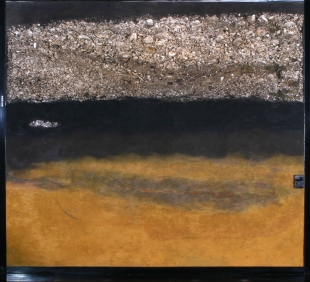
2-2 Pottery Found in the Kushiro Area
The styles of earthenware found in the Kushiro area range from the Jomon period (13,000–500 BCE) to the Satsumon period (600–1200 CE), indicating that the area has been settled for thousands of years. The earliest fragments from the Jomon period were either unpatterned or had patterns made with shells pressed on the surface. Later Jomon pottery was distinguished by cord patterns pressed into the clay.
The diversity of shapes increased through the late and post-Jomon periods, and fragments of plates and jars have been found from that time. Pottery fragments of the Satsumon period were thinner, with smooth, burnished surfaces. Some pieces from the eleventh century combine the shapes of Satsumon pottery with applied cord patterns, typical of earthenware found at archaeological sites along the northern coast of Hokkaido and on the island of Sakhalin. This blending of styles indicates there was contact between communities in eastern Hokkaido and those farther to the north.
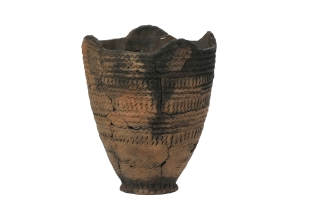
2-3 Post-Jomon Culture
Across most of Japan, the Neolithic Jomon period (13,000–500 BCE) was followed by the Yayoi period (300 BCE–300 CE), when rice cultivation, iron, and bronze were introduced from Eurasia and spread from the south as far as the northern tip of Honshu. But in Hokkaido, less than 100 kilometers farther north, people continued to survive by hunting and gathering. Though some new technologies, such as metal tools, were adopted through trade, rice cultivation did not take root, in part because Hokkaido’s climate was too cold. Instead, the same abundant natural resources that had sustained life during the Jomon period continued to support the traditional hunter-gatherer lifestyle, which defined the culture that developed here. This period of Hokkaido history is called the post-Jomon or epi-Jomon period (500 BCE–600 CE). Villages were located on the coast, where people could fish, hunt, and forage. Over time, communities moved inland, using rivers as transport and trade routes.
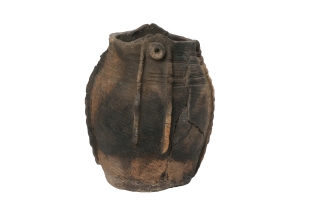
2-4 The Satsumon Period
The culture of the Satsumon period (600–1200 CE) was specific to Hokkaido and differed from that of much of the rest of Japan. It was a continuation of the hunter-gatherer culture of the Jomon period (13,000–500 BCE), with additional influences and technology from communities on Honshu to the south. Cooking stoves, ironware, and textiles were gradually introduced. The cold climate did not support rice cultivation, but people grew grains like millet and barley.
Satsumon pottery found in Kushiro has incised patterns made with a wooden spatula. Some pieces of Satsumon pottery have been found with both these incised patterns and the raised decorations typical of pottery from Okhotsk communities to the north. After the fifth century, people from the Eurasian continent settled areas around the Sea of Okhotsk, such as the Kuril Islands and Sakhalin. They are believed to have come from the Amur River basin, on what is now the border of eastern Russia and northern China. They lived in coastal communities, hunting larger marine animals such as whales and seals, and kept dogs and pigs. Contact increased between these northern people and the inhabitants of Hokkaido, as can be seen in the fusion of Satsumon pottery styles and Okhotsk motifs. Some archaeologists believe that this meeting of cultures gave rise to Ainu culture.
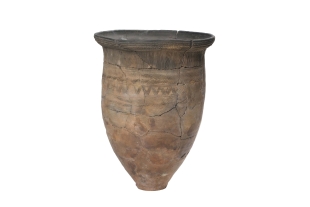
2-5 Koshu Mirror
This square bronze mirror was made in Huzhou, China during the Southern Sung period (1127–1279). It is known as a Koshu (Huzhou) mirror due to the Chinese inscription on the back, which includes Chinese characters that read Koshu-shin (Huzhou).
The mirror was unearthed during the excavation of a pit dwelling next to the Kushiro River, close to the Nusamai Bridge in downtown Kushiro. There was a village in this area during the Satsumon period (600–1200). The people lived in pit dwellings, which consisted of an earthen pit about a meter deep, covered by a thatched roof supported on wooden poles.
Similar mirrors of various shapes have been found along the coast of the Sea of Japan, from the Kinki region of central Honshu to the Tohoku region in the north. However, this is the only square Koshu mirror that has been found in Hokkaido. It is believed to have come to Kushiro from China through trade with the Okhotsk people, who settled areas around the Sea of Okhotsk after the fifth century.
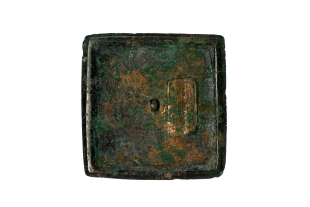
This English-language text was created by the Japan Tourism Agency.
このページに関するお問い合わせ
生涯学習部 博物館 博物館担当
〒085-0822 北海道釧路市春湖台1番7号 博物館
電話:0154-41-5809 ファクス:0154-42-6000
お問い合わせは専用フォームをご利用ください。
